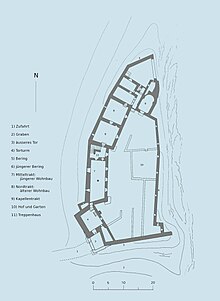Rhäzüns Castle
| Rhäzüns Castle | |
|---|---|
Burg Rhäzüns | |
m above the sea | |
| Site information | |
| Condition | Privately owned |
| Site history | |
| Built | before 960 |
| Garrison information | |
| Occupants | Barons of Rhäzüns |
Rhäzüns Castle (
History

Rhäzüns Castle may be one of the oldest castles in Switzerland. In 960
By the 1380s they had acquired land in
Over the next centuries, the castle and its strategically important lands traded owners often. In 1473 Conradin von Marmels acquired the castle from the Zollerns, though they retained the right to repurchase it. In 1497 the pro-French Count Trivulzio tried to buy the castle, but was countered by the Habsburgs who acquired it along with membership in the Grey League. Two years later, during the Swabian War, Three Leagues troops occupied the castle to prevent it from becoming a Habsburg stronghold. However, by 1553 it was a Habsburg fief held by the Counts of Marmels, who added a mill, bath houses, a jail and housing. Also, in 1553 the round bergfried on the eastern side of the castle had to be demolished, probably because the Hinterrhein river had so undercut the eastern side of the castle and wall that it was threatened with collapse.[1]
In 1553 it was acquired by Bartholomäus von Stampa, followed by Johann von Planta in 1558 and Rudolf von Schauenstein in 1573. It then went to the Planta-Wildenstein family for about a century. In 1674 the Habsburgs were able to take the castle away from Johann Heinrich von Planta and his
A few years later, in 1823, the canton sold the castle to private owners and until 1860 it was the home of the Vieli family. Later it was home to a school for girls before being abandoned and allowed to fall into disrepair. In the early 20th century it was repaired and in 1929 became a vacation resort. During World War II tourism dried up and the resort had to be abandoned. In 1960 it was acquired by Ems-Chemie[1] and after the company was acquired by SVP leader Christoph Blocher the castle was rented by Blocher from Ems-Chemie for the rest of his life. The castle is closed to tourists, except for fourth graders from the school in Rhäzüns who have been invited to tour the castle every year for over 30 years.[4]
Castle site

The castle is located on a cliff above the Hinterrhein river near the village of the same name. The original castle site was probably surrounded by a round ring wall. However, around the 16th century the river had undercut the eastern side of the castle which either collapsed or was demolished. Today the north and south walls end at the cliff while a newer wall runs along the cliff and forms the eastern wall. The 17th century gatehouse is located in the south-west corner of the wall.[2] The inner gate tower and the northern residential wing were built in the 14th century and still show frescoes of the coat of arms of the Barons as well as a hunting scene. During the 16th century the east wall was added after the destruction of the eastern tower and the rest of the castle was repaired and renovated. Around 1700 the outer gate house was added as was the chapel on the north side. The newer residential tract was also added in the 16th or 17th century.[3]
Gallery
-
Rhäzüns Castle and Rhäzüns village
-
View of the castle from the village
-
The castle and the Hinterrhein river
See also
- List of castles in Switzerland
References
- ^ a b c d "Burg Rhäzüns". www.burgenwelt.ch. Retrieved 3 July 2017.
- ^ a b "Schloss Rhäzüns". www.swisscastles.ch. Retrieved 3 July 2017.
- ^ a b Rhäzüns (Herrschaft) in German, French and Italian in the online Historical Dictionary of Switzerland.
- ^ "Schloss Rhäzüns wird seit 30 Jahren renoviert". Südostschweiz (in German). 24 September 2013. Retrieved 2017-07-03.



